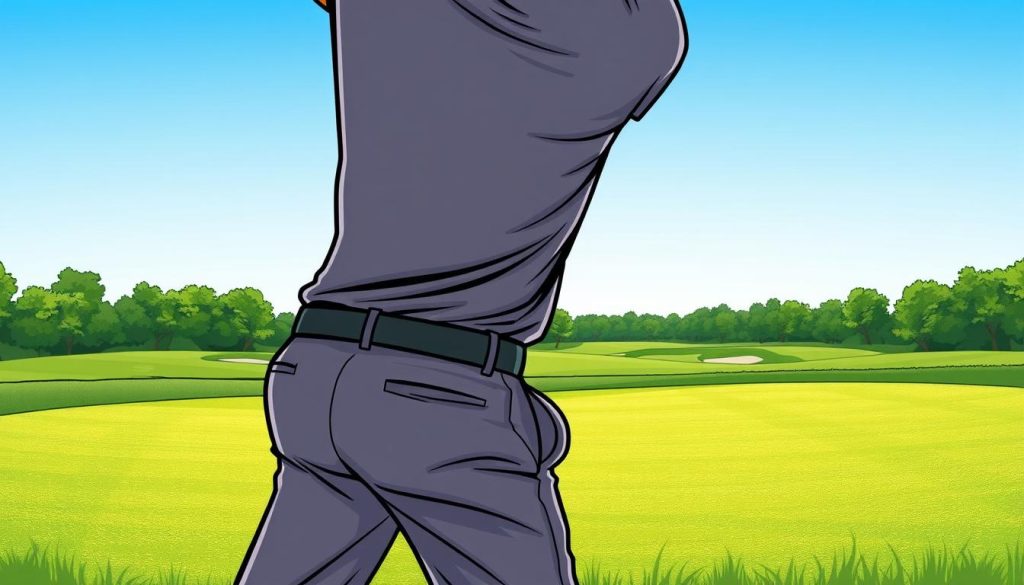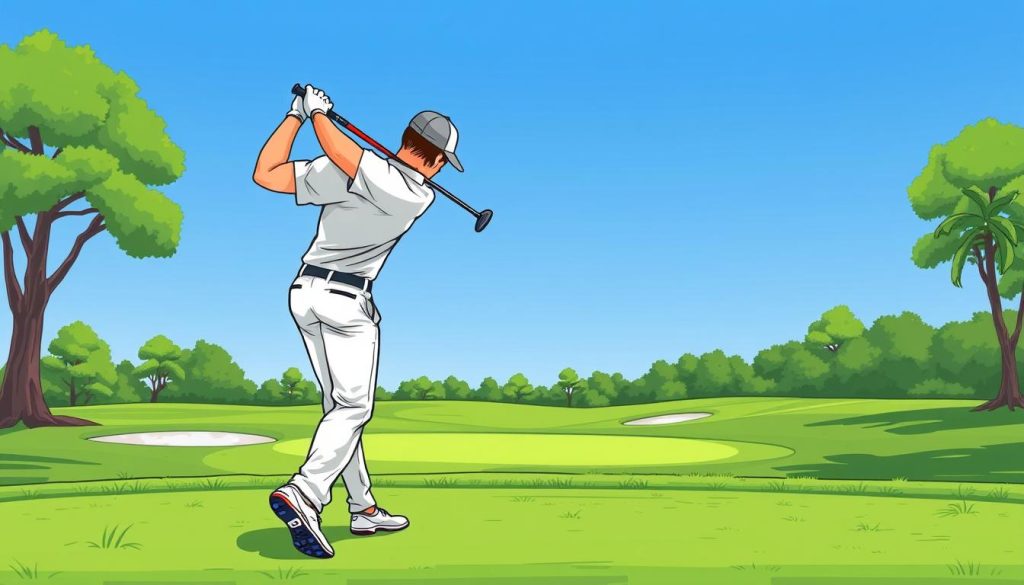Your golf backswing is key to a great shot. This guide will help you master your backswing and boost your game. We’ll cover the essential parts of a perfect backswing, from stance to club position. By focusing on these basics, you’ll get a consistent and strong backswing.
Key Takeaways
- A proper golf stance is crucial for a solid backswing
- Ball position varies depending on the club you’re using
- There are three main grip options: ten-finger, overlap, and interlock
- Focus on one or two swing thoughts during your backswing
- Maintain the correct swing plane to ensure a proper downswing
- Start your downswing with your lower body for maximum power
- Use tools like Swing Align to improve your golf swing mechanics
Understanding the Fundamentals of a Perfect Backswing
A solid backswing is key to a great golf shot. Let’s look at the main parts of a perfect backswing. These elements will help you succeed on the course.
The Role of Proper Stance and Grip
Your golf stance is vital for stability and power. Stand with your feet shoulder-width apart, parallel to the target line. Bend your knees a bit and keep your weight centered.
A good golf grip is also important. You can choose from baseball, overlap, or interlock styles. When you look down, you should see two knuckles on your top hand.
Creating an Athletic Position
An athletic golf position is essential for a smooth swing. Keep your spine straight and tilt from your hips. This posture lets you turn your shoulders fully and stay balanced.
Avoid slouching or standing too upright. These can limit your swing’s range.
Ball Position Basics
Ball position changes with club length. For longer clubs, place the ball more forward in your stance. With shorter clubs, put it closer to the center.
This adjustment helps you hit the ball better with each club.
| Club Type | Ball Position | Benefits |
|---|---|---|
| Driver | Inside left heel | Promotes upward strike, maximizes distance |
| Irons | Center to slightly forward | Enables clean contact, consistent trajectory |
| Wedges | Center of stance | Enhances control, improves accuracy |
Mastering these basics takes time and practice. Work on your golf stance, grip, and athletic position. Also, pay attention to ball position for each club. With regular practice, these skills will become natural, leading to a strong and accurate backswing.
Golf Swing Backswing Guide: Essential Components
The backswing is key in the golf swing sequence. It prepares you for a strong and accurate shot. Knowing the backswing’s parts can really boost your game.
A good backswing does two things. It aligns the club for accuracy. It also builds energy for power. Let’s look at the main backswing mechanics:
- Takeaway
- Wrist hinge
- Body turn
- Weight transfer
These parts work together for a solid backswing. A great backswing puts the club on the right plane and keeps the clubface square. It also separates your upper and lower body for more power.
Instead of focusing on a specific club position at the backswing’s end, focus on these key points. This will help you hit more consistent and powerful shots.
| Backswing Component | Purpose | Common Mistake |
|---|---|---|
| Takeaway | Initiates proper club path | Inside takeaway |
| Wrist hinge | Creates power and control | Early or late hinging |
| Body turn | Generates rotational power | Insufficient rotation |
| Weight transfer | Prepares for downswing power | Shifting weight too far back |
Remember, pros take about 0.75 seconds for their backswing. Practice for a smooth, controlled motion. This will prepare you for a strong downswing.
Mastering the Takeaway Phase
The golf takeaway is a key part of your swing. It sets the stage for a powerful motion. A good takeaway can help you hit better shots and lower your scores.
One-Piece Takeaway Technique
The one-piece takeaway is a vital technique in golf. It means moving your hands, arms, and shoulders together. This makes your backswing start smoothly.
The Rotary Swing method teaches moving your body a little to swing the club far. It’s about 6-8 feet.
Common Takeaway Mistakes
Many golfers make mistakes in the takeaway. These mistakes can hurt your shots and scores. Some common errors include:
- Pulling the club inside too quickly
- Pushing the club outside the target line
- Moving too fast during the takeaway
- Using only the hands and arms, neglecting body rotation
Maintaining Proper Alignment
Keeping your clubhead on the target line is key for a good takeaway. The Rotary Swing Tour method emphasizes body movement over club position. This helps keep your swing aligned right.
To get better at your takeaway, try using an alignment stick. This drill helps you feel the right movement and alignment. A good takeaway means a smoother swing and better results on the course.
The Importance of Shoulder Turn and Hip Rotation
A golf shoulder turn and hip rotation are key to power and consistency in your swing. The backswing sets the stage for a strong and accurate shot.

For the best results, aim for a 90-degree shoulder turn and 45-degree hip rotation. This stretches your left back and right buttock at the backswing’s peak.
Studies reveal that engaging lower body muscles can boost power by 100%. Focus on tightening your right hip and glutes for a better swing.
Mastering the Hip-Shoulder Relationship
Top golfers have mastered the hip-shoulder connection. This separation is crucial for efficient and powerful swings. Practice moving your hips while keeping your shoulders still, and vice versa, to enhance your swing.
| Element | Optimal Turn | Benefits |
|---|---|---|
| Shoulder Turn | 90 degrees | Increases power potential |
| Hip Rotation | 45 degrees | Enhances stability and control |
| Disassociation | 45 degrees difference | Improves swing efficiency |
Focus on feeling coiled, not just how far the club goes back. Modern methods stress efficient body rotation over club position. Mastering these will greatly improve your golf game.
Wrist Hinge and Club Position at Halfway Back
Mastering the golf wrist hinge and club position at the halfway back point is key. It’s vital for a strong and accurate swing. Let’s explore the essential elements of this crucial backswing phase.
Proper Wrist Hinge Timing
The wrist hinge is crucial for power and clubface control. When you hit the halfway back, your wrists should hinge fully. This happens naturally when your lead arm is parallel to the ground, known as the P3 position.
Club Face Position Check Points
At the halfway back, check your club face position. The shaft should be just under your right shoulder, with your hands covering your chest. This ensures you’re on the right swing plane. Keep the clubface in line with your left forearm for the best control.
Maintaining Swing Plane
To keep the swing plane right, move your arms back, up, and inward. Picture a straight line from your shoulders for the correct mechanics. Remember, the clubhead moves the farthest, so start the movement from there.
| Position | Description |
|---|---|
| P3 (Halfway Back) | Lead arm parallel to ground, wrists start hinging |
| Top of Backswing | Club parallel to ground for most golfers |
| P6 (Downswing) | Club shaft parallel to ground, more lag than P3 |
By focusing on these key aspects of wrist hinge and club position at the halfway back point, you’ll set yourself up for a more consistent and powerful golf swing.
Weight Transfer During the Backswing
Golf weight transfer is key to a strong and precise swing. Learning to move your weight right during the backswing can really boost your game.
Back Foot Pressure Points
Feel pressure on the inside of your trail foot during the backswing. This helps you stand firm for your swing. Try to put about 60% of your weight on your back foot by the top of your backswing.
Maintaining Balance
Keeping balance in your backswing is vital for a steady golf swing. While moving your weight, keep your upper body steady and avoid moving too much sideways. This balance makes your swing smoother and more powerful.
Common Weight Transfer Errors
Many golfers face challenges with weight transfer. A common mistake is the reverse pivot, where weight shifts to the front foot during the backswing. This can reduce power and accuracy. Another error is swaying, which messes up your swing plane and makes hitting the ball solidly hard.
| Weight Distribution | Backswing | Top of Swing | Impact |
|---|---|---|---|
| Ideal | 60% back foot | 60% back foot | 70% front foot |
| Common Error | 50% each foot | 50% each foot | 60% back foot |
Knowing about pressure points in your golf swing can enhance your technique. Practice slow, controlled swings to build muscle memory for better weight transfer. With practice, your swing will get stronger and more consistent. Understanding key mechanics, such as maintaining proper tempo and sequencing, is essential for refining your performance. Incorporating golf swing lag tips can help you generate more power and improve clubhead speed by delaying the release until the right moment. Focus on staying relaxed and letting your body naturally flow through the motion to achieve a smoother and more effective swing.
The Role of the Right Shoulder in Your Backswing
The right shoulder is key in your golf swing backswing. Getting it right can really boost your game. Many golfers miss this, but it’s vital for keeping the right swing plane and angles.
It’s important to keep your right shoulder up during the backswing. This stops an inside takeaway and keeps your head steady. It also stops your swing from moving too much, which can affect your distance to the ball.
To get the right shoulder position, focus on rotating it back and up. This helps you turn properly and prepares you for a strong downswing. Remember, your swing posture starts with your setup and continues through the backswing.
Common Mistakes to Avoid
- Dropping the right shoulder too early
- Lifting the left shoulder instead of turning
- Swaying laterally instead of rotating
By focusing on the right shoulder, you can make your swing more consistent and accurate. Practice this regularly to build muscle memory and improve your game.
| Correct Right Shoulder Movement | Incorrect Right Shoulder Movement |
|---|---|
| Rotates back and up | Drops or stays level |
| Maintains swing plane | Causes inside takeaway |
| Preserves address angles | Alters spine angle |
| Keeps head steady | Leads to excessive head movement |
Achieving the Perfect Top Position
Mastering the top of backswing position is key for a strong and accurate golf swing. Let’s look at the main parts that help you get into this perfect spot.
Lead Wrist Position
The lead wrist in golf is very important for controlling the clubface. At the top of your backswing, you want a flat lead wrist. This makes the clubface square and puts the club on the right path for a good downswing.
Shoulder-Hip Relationship
Shoulder-hip separation is crucial for power. When you reach the top of your backswing, your shoulders should turn more than your hips. This creates a coiled position, known as the X-factor, which builds energy for the downswing.
| Component | Ideal Position | Common Mistake |
|---|---|---|
| Lead Wrist | Flat | Cupped or bowed |
| Shoulders | 90-degree turn | Over-rotation |
| Hips | 45-degree turn | Excessive rotation |
Clubface Alignment
Proper clubface alignment at the top of your swing is vital for accuracy. Aim for a square to slightly closed clubface relative to your swing path. This position gives you the best control and precision as you move into the downswing.

Remember, getting the perfect top position takes practice and focus. Work on these key elements to boost your golf swing and lower your scores on the course.
Common Backswing Mistakes and How to Fix Them
Golf backswing errors can really hurt your game. By spotting and fixing these issues, you’ll play better. Let’s look at some common mistakes and how to fix them.
Wrist position is key in your backswing. Many beginners have trouble with wrist extension at the top. This messes up clubface alignment. To fix this, keep your wrists balanced throughout your swing.
This small change can help you hit the ball straighter and farther.
Proper aim is also a challenge for many golfers. Misalignment can lead to shots going off course. To improve, focus on your setup and aim. Even pros check their alignment often to stay consistent.
| Common Mistake | Impact | Fix |
|---|---|---|
| Incorrect ball position | Thin or pushed shots | Adjust ball position based on club length |
| Poor posture | Power loss, swing flaws | Focus on athletic stance, engage core |
| Improper grip | Inconsistent swing path | Adopt a neutral grip for better control |
| Tense hands | Restricted rotation | Loosen grip pressure before swinging |
Swing tempo is important in your backswing. Many struggle with a smooth motion. To fix this, try swinging with a metronome or count in your head.
A steady tempo helps you control your swing better and hit the ball harder.
Fixing backswing problems takes time and effort. Work on one thing at a time. Soon, you’ll see big improvements in your golf game.
Conclusion
Mastering your golf backswing is a journey that needs dedication and practice. This summary covers key elements: proper setup, one-piece takeaway, and more. By focusing on these, you’ll see big improvements in your backswing.
Consistency is key. Pros have a steady swing, while amateurs often don’t. Spend at least five minutes each session checking your grip. This simple step can greatly improve your technique.
For better backswing practice, keep your hands at the same height until they pass your right foot. This helps avoid losing power. Also, pay attention to your wrist position and chest and hip rotation for correct hand placement.
Adding specific drills to your routine can help a lot. Use a doorframe to check your swing path or a tee for follow-through. These exercises can make a big difference. Quality practice is more important than how much you practice. Focus on these basics and you’ll get a stronger, more efficient backswing.
FAQ
What are the key components of a perfect golf backswing?
How important is the takeaway in the golf backswing?
What is the ideal shoulder turn in a golf backswing?
How should weight transfer occur during the backswing?
What is the correct wrist hinge timing in the golf backswing?
How can I maintain the correct swing plane during my backswing?
What are some common backswing mistakes and how can I fix them?
How do I achieve the perfect top position in my backswing?
What is the X-factor in golf, and why is it important?
How can I improve my backswing consistency?
Source Links
- https://swingtrainer.com/blogs/instruction/golf-swing-basics?srsltid=AfmBOoq-nFmXogHINaHfJfTToIjEjLrs3gv4Lio049NFLhH0afMmSm8Q
- https://www.rotaryswing.com/golf-lessons-blog/how-to-start-your-backswing-golf-takeaway-techniques/
- https://hittingitsolid.com/blogs/news/make-a-great-golf-backswing
- https://golfinsideruk.com/golf-backswing-explained/
- https://skillest.com/blog/a-comprehensive-guide-to-mastering-the-golf-swing/
- https://www.performancegolf.com/blog/golf-backswing-the-key-to-unlocking-more-golf-swing-consistency?srsltid=AfmBOooP33PsI6rvvqDbb5FfnTgX71Y0YnaG9QMDtPjG1UkNqyaEmefo
- https://rotaryswing.com/c4/112204-golf-takeaway-overview
- https://www.performancegolf.com/blog/mastering-the-golf-takeaway-in-6-essential-steps?srsltid=AfmBOorC8hW36O8BIhI1FyuDzlRIxOBfdvHIaOboD-liZ0rWmcc7yOJb
- https://www.rukket.com/blogs/golf/mastering-the-golf-takeaway-simple-golf-tips-from-henry-fall-of-milo-lines-golf-academy?srsltid=AfmBOoqKFFHwRX8ls1UtLNl6mx5HRCTFTbkBVQ_FBLD_q_kpiCO4ld73
- https://rotaryswing.com/c4/112358-do-you-start-backswing-w-hips-or-shoulders
- https://simplifymotion.com/hip-turn-vs-shoulder-turn-why-its-important/
- https://www.jamesparkergolf.com/load-the-club-during-the-backswing/
- https://hackmotion.com/golf-swing-positions/
- https://www.golfmonthly.com/videos/golf-swing-tips/weight-distribution-in-the-golf-swing
- https://whygolf.com/blogs/whysguyscorner/weight-shift-in-golf-swing?srsltid=AfmBOorHRWNwtp3aAk66AfcFuVvKtlVtQL8sg3rnI3D3NQvCYUn75-Tw
- https://rotaryswing.com/golf-shoulder-turn
- https://hackmotion.com/right-arm-in-golf-swing/
- https://swingfit.net/golf-swing-mechanics/
- https://www.pantherrungolfclub.com/blog/29-the-ultimate-guide-to-the-perfect-golf-swing
- https://hackmotion.com/common-golf-swing-mistakes/
- https://collegeofgolf.keiseruniversity.edu/the-biggest-mistakes-you-are-making-with-your-golf-swing/
- https://danfordgolfinstruction.com/perfecting-your-golf-backswing-a-comprehensive-breakdown/
- https://nationalgcla.com/how-to-improve-your-golf-swing/


